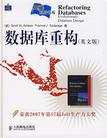数据库重构
出版时间:2007-6 出版社:人民邮电 作者:安布勒 页数:350 字数:470000
Tag标签:无
内容概要
重构技术已经在领域广泛的开发项目中证明了自身的价值——帮助软件专业人士改善系统的设计、可维护性、可扩展性和性能。本书首次披露了为数据库系统专门设计的强大重构技术。 本书展示了如何在不改变语义的情况下,对表结构、数据、存储过程及触发器等略作改动,就可以给数据库设计带来实质上的飞跃。 这是一本内容全面的参考、指南书,全面介绍了数据库重构涉及的每个基本观念,运用完整的实例,带领读者学习从重构简单的孤立数据库应用程序到重构复杂的多应用程序环境的全过程,并讲述了数据库重整的五大主要类别。读者将学会如何运用重构改善数据库结构、数据质量和参照完整性,如何同时对结构和方法进行重整。本书提供了用Oracle和Java建立的多种实例,并可以方便地转换成C#、C++、VB.NET等其他语言或DB2、SQL Server、MySQL、Sybase等其他数据库。 运用本书的技术和实例,读者可以减少浪费和重复工作,降低风险和成本,建立能够顺利发展以适应未来需求的数据库系统。
作者简介
Scott W.Ambler,世界一流的软件过程改进咨询顾问,开创了敏捷建模、敏捷数据、企业统一过程(Enterprise UP)以及敏捷统一过程方法论。曾在软件开发、JavaOne、OOPSLA、DAMA等会议上作主题发言和演讲。
书籍目录
Chapter 1:Evolutionary Database Development 1.1 Database Refactoring 1.2 Evolutionary Data Modeling 1.3 Database Regression Testing 1.4 Configuration Management of Database Artifacts 1.5 Developer Sandboxes 1.6 Impediments to Evolutionary Database Development Techniques 1.7 What You Have Learned Chapter 2:Database Refactoring 2.1 Code Refactoring 2.2 Database Refactoring 2.3 Categories of Database Refactorings 2.4 Database Smells 2.5 How Database Refactoring Fits In 2.6 Making It Easier to Refactor Your Database Schema 2.7 What You Have Learned Chapter 3:The Process of Database Refactoring 3.1 Verify That a Database Refactoring Is Appropriate 3.2 Choose the Most Appropriate Database Refactoring 3.3 Deprecate the Original Database Schema 3.4 Test Before, During, and After 3.5 Modify the Database Schema 3.6 Migrate the Source Data 3.7 Refactor External Access Program(s) 3.8 Run Your Regression Tests 3.9 Version Control Your Work 3.10 Announce the Refactoring 3.11 What You Have Learned Chapter 4:Deploying into Production 4.1 Effectively Deploying Between Sandboxes 4.2 Applying Bundles of Database Refactorings 4.3 Scheduling Deployment Windows 4.4 Deploying Your System 4.5 Removing Deprecated Schema 4.6 What You Have Learned Chapter 5:Database Refactoring Strategies 5.1 Smaller Changes Are Easier to Apply 5.2 Uniquely Identify Individual Refactorings 5.3 Implement a Large Change by Many Small Ones 5.4 Have a Database Configuration Table 5.5 Prefer Triggers over Views or Batch Synchronization 5.6 Choose a Sufficient Transition Period 5.7 Simplify Your Database Change Control Board (CCB) Strategy 5.8 Simplify Negotiations with Other Teams 5.9 Encapsulate Database Access 5.10 Be Able to Easily Set Up a Database Environment 5.11 Do Not Duplicate SQL 5.12 Put Database Assets Under Change Control 5.13 Beware of Politics 5.14 What You Have Learned 68 Online Resources Chapter 6:Structural Refactorings Common Issues When Implementing Structural Refactorings Drop Column Drop Table Drop View Introduce Calculated Column Introduce Surrogate Key Merge Columns Merge Tables Move Column Rename Column Rename Table Rename View Replace LOB With Table Replace Column Replace One-To-Many With Associative Table Replace Surrogate Key With Natural Key Split Column Split Table Chapter 7:Data Quality Refactorings Common Issues When Implementing Data Quality Refactorings Add Lookup Table Apply Standard Codes Apply Standard Type Consolidate Key Strategy Drop Column Constraint Drop Default Value Drop Non-Nullable Introduce Column Constraint Introduce Common Format Introduce Default Value Make Column Non-Nullable Move Data Replace Type Code With Property Flags Chapter 8:Referential Integrity Refactorings Add Foreign Key Constraint Add Trigger For Calculated Column Drop Foreign Key Constraint Introduce Cascading Delete Introduce Hard Delete Introduce Soft Delete Introduce Trigger For History Chapter 9:Architectural Refactorings Add CRUD Methods Add Mirror Table Add Read Method Encapsulate Table With View Introduce Calculation Method Introduce Index Introduce Read-Only Table Migrate Method From Database Migrate Method To Database Replace Method(s) With View Replace View With Method(s) Use Official Data Source Chapter 10:Method Refactorings 10.1 Interface Changing Refactorings 10.2 Internal Refactorings Chapter 11:Transformations Insert Data Introduce New Column Introduce New Table Introduce View Update Data Appendix:The UML Data Modeling Notation Glossary References and Recommended Reading Index
编辑推荐
《数据库重构(英文版)》荣获2007年第17届Jolt大奖的生产效率奖!
图书封面
图书标签Tags
无
评论、评分、阅读与下载
用户评论 (总计7条)
- 英文简单洗练,可以让你更多的了解敏捷开发以及重构,要在不断的重构中完善程序、完善数据库,其实也在完善着自己,在java-oracle-hibernate的世界里翩翩起舞吧。让我们一起将重构进行到底。
- 适合在看完<重构改善既有代码的设计(英文注释版)>后阅读.可以有效改善代码质量
- 可能是英文不够好,看起来没感觉,没看完就成收藏了
- 很全面、很实用,对于持续改进数据库结构和性能有指导作用
- http://www.trydofor.com/a9w3-auhome/trydofor/article/2010/0607170631/body.htm
作者啰嗦点,译者外行点。
数据和数据库重构,基本上都是组合拳,牵涉到所有角色。
书中是分节动作,总结起来就是做事6要素:
首先What,Why,How,然后Where,When,最后安排Who。 - 买了5本书 挑了这本做赠品。没想到 倒是最先看完的,花了3、4天的业余时间。想来,把数据库重构的各方各面一一列举,比起代码重构,书中讲述最多的是如何来保证数据的安全。对于线上系统的重构尤其如此,一个完好的数据安全机制是本书最值得称赞的地方。
- 无疑数据库重构一直以来就是很少人敢做的事,因为数据库schema、甚至是数据和系统的强耦合性,这本书和《重构》一样,可以在需要进行重构的时候来查找对应的方法。
相关图书
- 蘋果核戰記
- 秦汉史(上册)
- 秦汉问题研究
- Visual C++程序员成长攻略
- C++Builder程序员成长攻略
- 实用C语言FPGA编程
- Visual C++程序开发范例宝典
- 风险资本治理机制研究
- 面向对象程序设计C++版
- 微机原理与接口技术简明教程
- 全国大学生电子设计竞赛培训系列教程
- 简易自我催眠法
- 钢铁是怎样炼成的
- Arthur and the Best Coach Ever 亚瑟与最棒的教练
- 安装与重装操作系统
- 纯爱
- 會飲篇
- 电镀工人技术问答
- 淮河临淮岗洪水控制工程设计与施工技术
- 20世纪英美诗歌导读
- 英语畅谈世界文化100主题
- 脱硫工程技术与设备
- 电视机原理与维修教程
- 汤姆。索亚历险记
- 铣工技术与工艺改进
